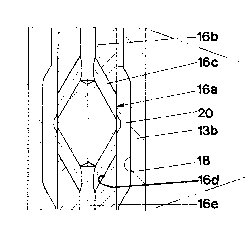Une partie des informations de ce site Web a été fournie par des sources externes. Le gouvernement du Canada n'assume aucune responsabilité concernant la précision, l'actualité ou la fiabilité des informations fournies par les sources externes. Les utilisateurs qui désirent employer cette information devraient consulter directement la source des informations. Le contenu fourni par les sources externes n'est pas assujetti aux exigences sur les langues officielles, la protection des renseignements personnels et l'accessibilité.
L'apparition de différences dans le texte et l'image des Revendications et de l'Abrégé dépend du moment auquel le document est publié. Les textes des Revendications et de l'Abrégé sont affichés :
| (12) Demande de brevet: | (11) CA 2009861 |
|---|---|
| (54) Titre français: | OUTIL DE FORAGE |
| (54) Titre anglais: | DRILL BIT |
| Statut: | Réputée abandonnée et au-delà du délai pour le rétablissement - en attente de la réponse à l’avis de communication rejetée |
| (51) Classification internationale des brevets (CIB): |
|
|---|---|
| (72) Inventeurs : |
|
| (73) Titulaires : |
|
| (71) Demandeurs : |
|
| (74) Agent: | GOWLING WLG (CANADA) LLP |
| (74) Co-agent: | |
| (45) Délivré: | |
| (22) Date de dépôt: | 1990-02-12 |
| (41) Mise à la disponibilité du public: | 1990-08-13 |
| Licence disponible: | S.O. |
| Cédé au domaine public: | S.O. |
| (25) Langue des documents déposés: | Anglais |
| Traité de coopération en matière de brevets (PCT): | Non |
|---|
| (30) Données de priorité de la demande: | ||||||
|---|---|---|---|---|---|---|
|
ABSTRACT OF THE DISCLOSURE
The present invention relates to a drill bit (11) intended to
be included in a drill string (10) for top hammer drilling,
said drill string (10) including a set of central rod members
(12) for transferring impact energy to the drill bit (11) and
a set of tubular members (13) surrounding the set of rod
members (12) for transferring rotation to the drill bit (11).
The invention also relates to a tubular member (13b) and to a
drill string (10). In drilling equipments of the type
mentioned above it is favourable - especially for greater
diameters, preferably above 125 mm - to guide the flushing
medium in an internal channel in the set of rod members (12).
In order to guarantee lubrication of the splines coupling
(14) through the lubricant that is mixed into the flushing
medium, an intermediate section (16a) of the drill bit (11)
is provided with branch channels (16c, 16d) to discharge the
flushing medium to and from a recess (18) in the space
between the drill bit (11) and the set of tubular members (13).
Note : Les revendications sont présentées dans la langue officielle dans laquelle elles ont été soumises.
Note : Les descriptions sont présentées dans la langue officielle dans laquelle elles ont été soumises.

2024-08-01 : Dans le cadre de la transition vers les Brevets de nouvelle génération (BNG), la base de données sur les brevets canadiens (BDBC) contient désormais un Historique d'événement plus détaillé, qui reproduit le Journal des événements de notre nouvelle solution interne.
Veuillez noter que les événements débutant par « Inactive : » se réfèrent à des événements qui ne sont plus utilisés dans notre nouvelle solution interne.
Pour une meilleure compréhension de l'état de la demande ou brevet qui figure sur cette page, la rubrique Mise en garde , et les descriptions de Brevet , Historique d'événement , Taxes périodiques et Historique des paiements devraient être consultées.
| Description | Date |
|---|---|
| Inactive : CIB de MCD | 2006-03-11 |
| Inactive : CIB de MCD | 2006-03-11 |
| Inactive : CIB de MCD | 2006-03-11 |
| Inactive : Abandon.-RE+surtaxe impayées-Corr envoyée | 1997-02-12 |
| Inactive : Demande ad hoc documentée | 1997-02-12 |
| Le délai pour l'annulation est expiré | 1994-08-13 |
| Demande non rétablie avant l'échéance | 1994-08-13 |
| Réputée abandonnée - omission de répondre à un avis sur les taxes pour le maintien en état | 1994-02-14 |
| Inactive : Demande ad hoc documentée | 1994-02-14 |
| Demande publiée (accessible au public) | 1990-08-13 |
| Date d'abandonnement | Raison | Date de rétablissement |
|---|---|---|
| 1994-02-14 |
Les titulaires actuels et antérieures au dossier sont affichés en ordre alphabétique.
| Titulaires actuels au dossier |
|---|
| SANDVIK AB |
| Titulaires antérieures au dossier |
|---|
| LARS K. LARSSON |
| SVEN P. LILJEBRAND |